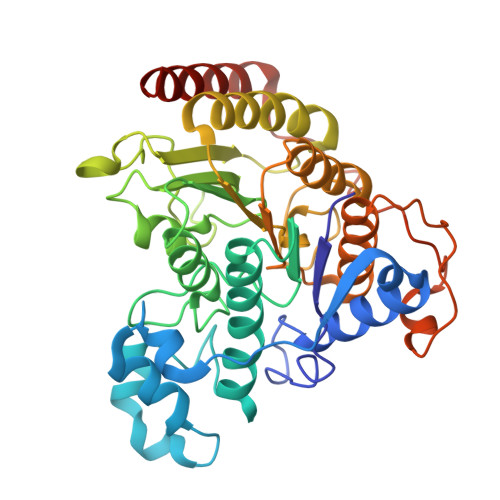❮
Member 1 of 2
❯

Explore in 3D: Sequence Alignments
Histone deacetylase 3
UniProtKB accession: O15379
Grouped By: Matching UniProtKB accession
Group Content:
Polymer Entities matching query 2
Go to UniProtKB: O15379
UniProtKB description: Histone deacetylase that catalyzes the deacetylation of lysine residues on the N-terminal part of the core histones (H2A, H2B, H3 and H4), and some other non-histone substrates (PubMed:21030595, PubMed:21444723, PubMed:23911289, PubMed:25301942, PubMed:28167758, PubMed:28497810, PubMed:32404892, PubMed:22230954). Histone deacetylation gives a tag for epigenetic repression and plays an important role in transcriptional regulation, cell cycle progression and developmental events (PubMed:23911289). Histone deacetylases act via the formation of large multiprotein complexes, such as N-Cor repressor complex, which activate the histone deacetylase activity (PubMed:23911289, PubMed:22230954). Participates in the BCL6 transcriptional repressor activity by deacetylating the H3 'Lys-27' (H3K27) on enhancer elements, antagonizing EP300 acetyltransferase activity and repressing proximal gene expression (PubMed:23911289). Acts as a molecular chaperone for shuttling phosphorylated NR2C1 to PML bodies for sumoylation (By similarity). Contributes, together with XBP1 isoform 1, to the activation of NFE2L2-mediated HMOX1 transcription factor gene expression in a PI(3)K/mTORC2/Akt-dependent signaling pathway leading to endothelial cell (EC) survival under disturbed flow/oxidative stress (PubMed:25190803). Regulates both the transcriptional activation and repression phases of the circadian clock in a deacetylase activity-independent manner (By similarity). During the activation phase, promotes the accumulation of ubiquitinated BMAL1 at the E-boxes and during the repression phase, blocks FBXL3-mediated CRY1/2 ubiquitination and promotes the interaction of CRY1 and BMAL1 (By similarity). The NCOR1-HDAC3 complex regulates the circadian expression of the core clock gene BMAL1 and the genes involved in lipid metabolism in the liver (By similarity). Also functions as a deacetylase for non-histone targets, such as KAT5, MEF2D, MAPK14, RARA and STAT3 (PubMed:15653507, PubMed:21030595, PubMed:21444723, PubMed:25301942, PubMed:28167758). Serves as a corepressor of RARA, mediating its deacetylation and repression, leading to inhibition of RARE DNA element binding (PubMed:28167758). In association with RARA, plays a role in the repression of microRNA-10a and thereby in the inflammatory response (PubMed:28167758). In addition to protein deacetylase activity, also acts as a protein-lysine deacylase by recognizing other acyl groups: catalyzes removal of (2E)-butenoyl (crotonyl), lactoyl (lactyl) and 2-hydroxyisobutanoyl (2-hydroxyisobutyryl) acyl groups from lysine residues, leading to protein decrotonylation, delactylation and de-2-hydroxyisobutyrylation, respectively (PubMed:28497810, PubMed:29192674, PubMed:34608293, PubMed:35044827). Catalyzes decrotonylation of MAPRE1/EB1 (PubMed:34608293). Mediates delactylation NBN/NBS1, thereby inhibiting DNA double-strand breaks (DSBs) via homologous recombination (HR) (PubMed:38961290).
Group Members:
Query History
❮
1 / 1
❯
Release Date:
Structure Features
Determination Methodology
Sequence Features
Number of Source Taxonomies
Experimental Features
Experimental Method
Resolution
Organisms
Organism
Taxonomy
Protein Domains
CATH Domain
ECOD Domain
PFAM Domain
InterPro Domain
Function
Enzyme Classification
GO Molecular Function
[ 13+ ]
GO Biological Process
[ 19+ ]
GO Cellular Component
Disease Association












